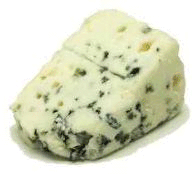Creator of Penicillin "The Wonder Drug" *Contact |
 |
| Home | General Information | Reproduction | Relationships | Penicillin "The Wonder Drug" |
|
Relatives
The following
organisms are close relatives of Penicillium chrysogenum.
There are numerous related fungi which I will not be
mentioning, however.
The following fungi were chose based on popularity, morphological
similarities (all belong to the Penicillium genus and contain
a paintbrush-like conidiophore), as well as molecular similarities
based on DNA similarities.
Penicillium roquefortii
Not all
products of P. roquefortii are beneficial, however.
The fungus is also known to produce a tremor-inducing
mycotoxin (a toxin produced by a fungus) which is called
roquefortine. It is
included in a larger group of mycotoxins called Penitrem A.
It is characterized by severe muscle tremors, sweating, and
loss of speech. Most
cases are seen in animals (usually dogs) which have ingested moldy
foods. Other cases have
been seen in factory workers who have constant, direct contact with
P. roquefortii.
Penicillium fumiculosum
Like
all other fungus, Penicillium fumiculosum is one of nature’s
finest recyclers.
However, this fungus goes a step further; it is one of the best
decomposers of almost all types of plastic fibers.
P. fumiculosum is also used as an antifungal
antibiotic called Wortmannin.
Pencillium expansum When you see an apple or pear covered in blue, fuzzy mold, you’re more than likely looking at the spores from Penicillium expansum. 
P. expansum is also known to produce a cancer-causing mycotoxin called patulin. Though levels of patulin are checked during fruit processing, it has produced harmful effects on people and animals. On a less extreme level, patulin also makes fruit distasteful. In order to combat this fungus as well as any unwanted mycotoxins, fruit producers use fungicides after harvest as well as a variety of other methods. Penicillium marneffei Lastly, the fungus Penicillium marneffei is known to cause the lethal infection penicillosis marneffei which is characterized by fever, anemia, weight loss, and lesions along with many other symptoms. Similar to other infections caused by Penicillium species, penicillosis marneffei is most prevalent in people suffering from weak immune systems. It is extremely common in areas which have a high incidence of AIDS. The appearance of P. marneffei infections is rising in direct correlation with the increasing appearance of AIDS. Bamboo rats are thought to be an intermediate host between the fungus and humans. However, continuing research is trying to determine whether the rats are merely infected or if they are in fact the cause of human infection. You can learn more about P. marneffei and related infections at the homepage of Penicillium marneffei.
|
|

